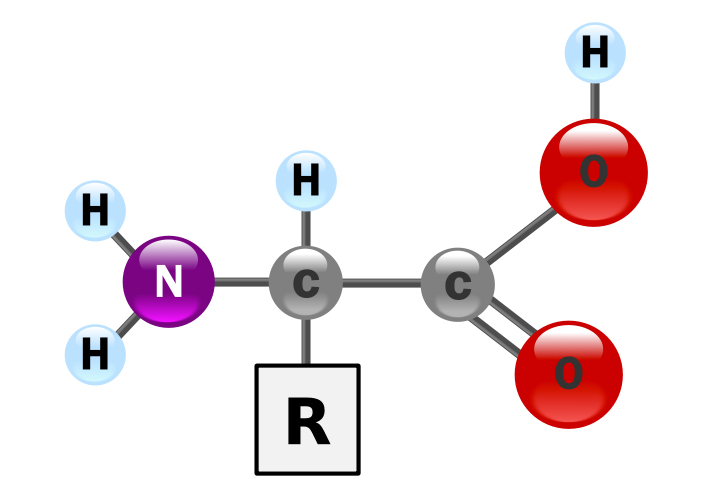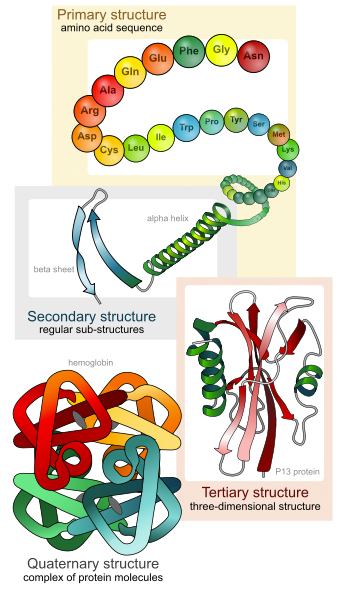Enzymes are proteins, which are made up of amino acids. It was mentioned previously that the type and order of amino acids in a protein sequence impact the shape and therefore the function of different enzymes.
Amino Acid Structure
There are twenty common amino acids used by living organisms
7
. The basic structure of amino acids is a compound consisting of a carboxyl group and amino group, both covalently bonded to a central carbon atom
7
. Amino acids get their name from this amino and carboxyl group attached to the central carbon
3
. Additionally, there is hydrogen and an R group attached to the carbon; the R group is known as a side chain and is what is responsible for the difference in properties of the twenty amino acids
7
. These twenty amino acids are a vital part of all proteins in the human body and are necessary for life
5
. These amino acids can be divided into two groups: essential and non-essential amino acids. Essential amino acids are ones that cannot be created in the body and must be obtained through food; non-essential amino acids can be created from the chemical found in our bodies
3
. Although we focus on the 20 amino acids essential for humans, it is estimated that there are over 100 amino acids present in nature
3
. A diagram below shows the basic structure of amino acids:

http://en.wikipedia.org/wiki/File:AminoAcidball.svg
Due to the common skeleton structure of all amino acids they have relatively constant percent compositions by mass: 50-55 percent carbon, 7 percent hydrogen, 23 percent oxygen, 16 percent nitrogen and 1 percent sulfur
5
. The molar mass of amino acids ranges from 5000 g to 1 x 10
7
g per mole, depending on the R-group
5
.
Peptide Bonds
Amino acids are joined together through peptide bonds to create polypeptide chains. Peptide bonds are created through condensation reactions between the amino group on one amino acid and the carboxyl group on another amino acid
5
. This reaction is called a condensation reaction because water is one of the products. The image below shows two amino acids undergoing a condensation reaction to create a dipeptide.

http://en.wikipedia.org/wiki/File:AminoacidCondensation.svg
The dipeptide that is formed in the reaction shown above will then continue to undergo condensation reactions with other amino acids and the final product will be a polymer of amino acids, known as a polypeptide
5
. Polypeptides generally consist of 100 or more amino acids, which is why there are so many different proteins that can be generated from the 20 amino acids that exist in the human body
5
.
Protein Folding
Proteins are polymers of amino acids, meaning they are composed of many amino acids strung together through peptide bonds. The number and sequence of amino acids in a protein molecule determine the protein's structure and function
5
. Protein structure can be divided into four levels of organization: primary, secondary, tertiary and quaternary structure. The primary structure is the unique amino acid sequence of the polypeptide chain
5
.
Next, there are two common structures for the secondary structure of protein molecules: the alpha helix and the beta-pleated sheet. The alpha helix structure arises from intramolecular forces, hydrogen bonds, which occur between the groups of amino acids
5
. This forms a rod-like structure known as the alpha helix. The beta-pleated sheet is formed by intermolecular hydrogen bonds that occur between adjacent chains of amino acids
5
.
The tertiary structure of protein molecules refers to the three-dimensional structure that is stabilized by dispersion forces, hydrogen bonding, and other intermolecular forces
5
. The tertiary structure differs from the secondary structure in that is can include forces that occur between multiple chains of polypeptides, since proteins can be made up of more than one peptide chain.
The quaternary structure is the overall arrangement of the peptide chains in proteiat
5
. The image below shows a protein sequence at each level of structure.

http://en.wikipedia.org/wiki/File:Main_protein_structure_levels_en.svg
It is the arrangement and sequence of amino acids at the primary structure level that impacts the overall shape and therefore function of proteins. It is the shape of enzymes that impacts how they interact with substrates and catalyze chemical reactions.